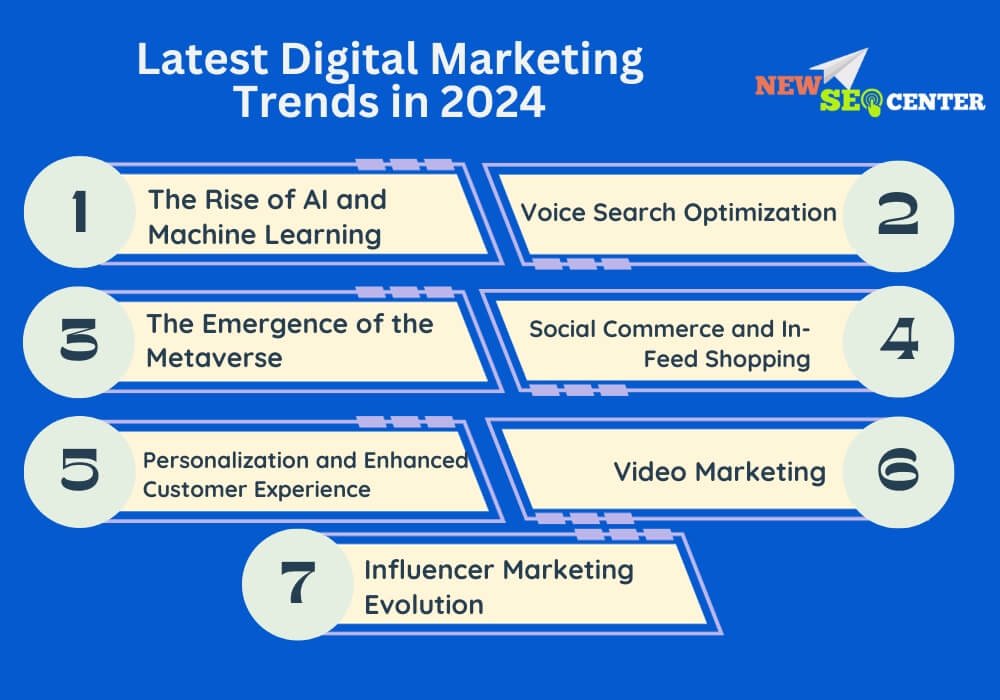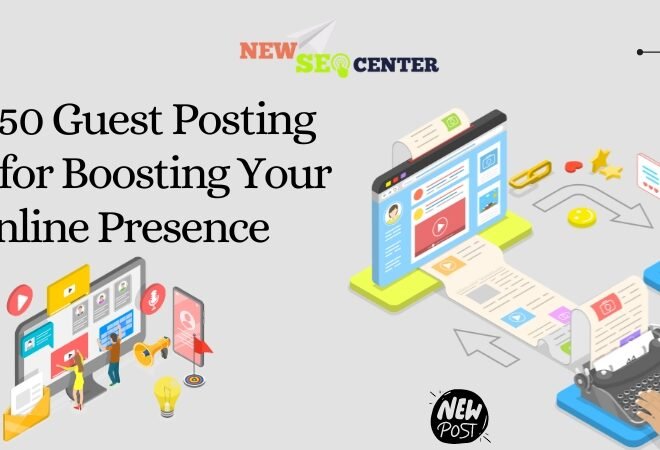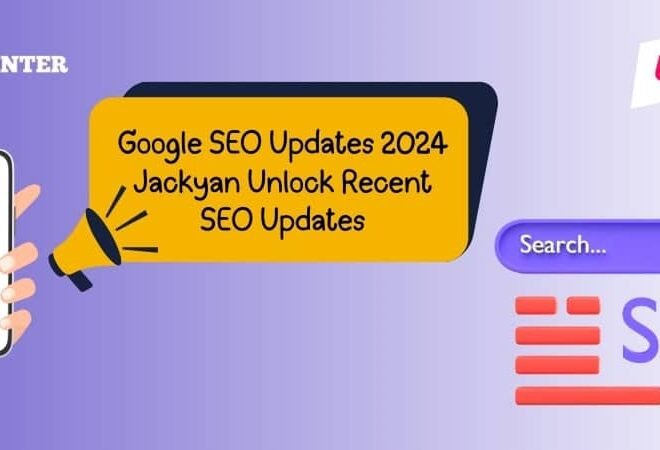
Latest Digital Marketing Trends for 2024
Introduction
As we step into a new era of digital innovation, New SEO Center, a leading provider of SEO latest blog and news, brings to the forefront the essential digital marketing trends of 2024. This year, the landscape of digital marketing continues to evolve rapidly, influenced by groundbreaking technologies and shifting consumer behaviors. In this dynamic environment, staying informed about the latest trends is crucial for businesses looking to maintain a competitive edge. Our comprehensive guide delves into the key strategies and insights that will shape the digital marketing domain this year, offering valuable perspectives for businesses aiming to thrive in the digital sphere.
Latest Digital Marketing Trends in 2024

The latest digital marketing trends in 2024 encompass a range of innovative strategies and technologies. Here’s a concise overview:
- The Rise of AI and Machine Learning: Leveraging advanced analytics for personalized marketing.
- Voice Search Optimization: Adapting SEO strategies for voice-activated searches.
- The Emergence of the Metaverse: Exploring marketing opportunities in virtual environments.
- Social Commerce and In-Feed Shopping: Integrating shopping experiences into social media platforms.
- Personalization and Enhanced Customer Experience: Tailoring content to individual user preferences.
- Video Marketing: Continuing the trend of engaging audiences through diverse video content.
- Influencer Marketing Evolution: Shifting towards authentic, transparent collaborations with micro and nano influencers.
These trends indicate a continual evolution towards more personalized, technology-driven marketing strategies.
The Rise of AI and ML in Digital Marketing Trends
The integration of AI and Machine Learning (ML) is revolutionizing the landscape of digital marketing, digital marking trend in 2024. This advancement is redefining how marketers approach campaigns, data analysis, and customer engagement.
Understanding AI and ML in Marketing
Artificial Intelligence (AI) and Machine Learning (ML) are revolutionizing digital marketing, offering unprecedented capabilities in understanding and engaging customers. These technologies process vast amounts of data to identify patterns and insights, enabling more effective marketing strategies.
Personalization at Scale
AI and ML allow for personalization at an extraordinary scale, tailoring marketing messages and experiences to individual consumer preferences, thus enhancing engagement and conversion rates.
Predictive Analytics
Through predictive analytics, businesses can anticipate customer needs and behaviors, allowing for proactive marketing decisions. This predictive power transforms how companies approach their audience, offering more relevant and timely interactions.
Enhanced Customer Insights
AI-driven tools provide deeper insights into customer behaviors and preferences, enabling businesses to refine their marketing strategies for maximum impact and efficiency.
Chatbots and Customer Service
Chatbots, powered by AI, are revolutionizing customer service in digital marketing. They provide instant, personalized assistance, improving customer experience and freeing up human resources for more complex tasks.
Real-Time Decision Making
Real-time decision-making is facilitated by AI and ML, allowing marketers to instantly adapt strategies based on current data and trends, making marketing efforts more agile and responsive.
Ethical Considerations and Challenges
As AI and ML become more prevalent, ethical considerations and challenges arise, such as data privacy and the potential for biased algorithms. Companies must navigate these issues carefully to maintain consumer trust.
The Future of AI in Marketing
The future of AI in marketing promises even more advanced capabilities, with potential developments in predictive personalization, automated content creation, and more sophisticated customer journey mapping. Businesses that embrace these technologies will find themselves at the forefront of the digital marketing revolution.
In summary, the rise of AI and Machine Learning is a pivotal aspect of current digital marketing trends, offering exciting opportunities for personalization, predictive analytics, and real-time decision-making, while also presenting unique ethical challenges and considerations for the future.
Voice Search Optimization in Digital Marketing Trends
Voice search optimization is becoming a pivotal aspect of digital marketing strategies as the usage of voice-activated devices grows exponentially. This shift necessitates a rethinking of traditional SEO techniques to cater to the nuances of voice search.
The Growing Importance of Voice Search
The surge in voice search usage is redefining search queries, making them more conversational and long-tail. Businesses must adapt to this trend to remain visible in voice search results.
Understanding Voice Search Behavior
Voice search behavior often differs from traditional typing. Queries tend to be longer, more natural, and question-based, necessitating a change in keyword strategy to match this conversational tone.
Optimizing for Local SEO
Local SEO becomes crucial with voice search, as many voice queries are local in nature. Businesses must ensure their local listings are accurate and complete to capitalize on this trend.
Structuring Content for Voice Search
Content needs to be structured to align with the conversational nature of voice queries. This involves creating content that directly answers questions and adopts a more natural, spoken language style.
Leveraging Featured Snippets
Featured snippets are often the source of voice search answers. Optimizing content to rank as a featured snippet can significantly increase visibility in voice search results.
The Role of Schema Markup
Schema markup helps search engines understand the context of website content, making it easier to match with relevant voice queries. Implementing this effectively can enhance a site’s voice search compatibility.
Mobile Optimization
As most voice searches are performed on mobile devices, mobile optimization is crucial. This includes fast loading times, mobile-friendly design, and easy navigation.
Challenges and Future Directions
Voice search optimization presents unique challenges, such as understanding the nuances of spoken language and keeping up with the rapidly evolving technology. The future will likely bring even more sophisticated AI and voice recognition advancements, making ongoing adaptation essential for success in digital marketing.
The Emergence of the Metaverse in Digital Marketing
The Metaverse, an emerging virtual space, is rapidly becoming a significant frontier for digital marketing. As this new dimension unfolds, marketers are exploring innovative ways to engage with audiences in these virtual environments.
Understanding the Metaverse
The Metaverse represents a collective virtual shared space, created by the convergence of virtually enhanced physical reality, augmented reality (AR), and the internet. It offers an immersive experience that is shaping new consumer behaviors and preferences.
Marketing Opportunities in the Metaverse
Within the Metaverse, marketers have unique opportunities to create immersive brand experiences, host virtual events, and engage with audiences in novel ways that transcend traditional digital platforms.
Challenges in Marketing within the Metaverse
Navigating the Metaverse poses challenges, including understanding its rapidly changing landscape, technological constraints, and developing strategies that resonate with a virtual audience.
The Future of the Metaverse in Marketing
As the Metaverse evolves, it is set to revolutionize the marketing world with possibilities like virtual storefronts and interactive, 3D advertising, redefining consumer engagement.
Preparing for the Metaverse
Businesses must start preparing for the Metaverse by staying informed about technological advancements, experimenting with AR and VR, and considering how their brand can authentically engage in these new virtual spaces.
The Metaverse is poised to offer a transformative platform for digital marketing, presenting a blend of challenges and opportunities for innovative, forward-thinking marketers.
Social Commerce and In-Feed Shopping in Digital Marketing
Social commerce and in-feed shopping represent significant shifts in the digital marketing landscape, merging social media engagement with e-commerce efficiency.
The Rise of Social Commerce
Social commerce involves selling products directly through social media platforms. This trend leverages the vast user base of these platforms, providing a convenient and engaging shopping experience.
In-Feed Shopping: A Seamless Experience
In-feed shopping allows for the integration of product purchases within the natural flow of a social media feed. This seamless approach streamlines the shopping experience, allowing users to purchase products without leaving the platform.
Advantages of Social Commerce
- Enhanced Engagement: Leveraging the interactive nature of social media.
- Targeted Reach: Utilizing user data for personalized marketing.
- Increased Convenience: Simplifying the path to purchase.
Challenges in Social Commerce
- Maintaining Brand Authenticity: Balancing promotional content and genuine engagement.
- Navigating Platform Limitations: Each platform has unique constraints and opportunities.
- Data Privacy Concerns: Ensuring customer data security and trust.
Future Trends in Social Commerce
Emerging trends include augmented reality (AR) try-ons, influencer collaborations, and the integration of AI for personalized recommendations, setting the stage for an even more immersive social shopping experience.
Preparing for the Shift to Social Commerce
Businesses need to adapt by understanding social platform algorithms, investing in quality content, and exploring innovative social media features to engage with their audience effectively.
The evolution of social commerce and in-feed shopping is transforming the way consumers interact with brands on social media, presenting a dynamic and interactive frontier for digital marketing.
Personalization and Customer Experience in Digital Marketing
Personalization in digital marketing has become a cornerstone for enhancing customer experience, leading to more effective and engaging marketing strategies.
The Importance of Personalization
Personalization in digital marketing is not just a trend; it’s a customer expectation. Tailoring content, offers, and experiences to individual preferences significantly boosts engagement and loyalty.
Data-Driven Personalization
- Leveraging Customer Data: Utilizing data analytics to understand customer preferences.
- Behavioral Targeting: Crafting marketing messages based on user behavior.
- Segmentation: Grouping customers based on similar characteristics for targeted communication.
Enhancing Customer Experience
- Customized Content: Creating content that resonates with individual customers.
- Personalized Recommendations: Suggesting products or services based on past interactions.
- Omnichannel Experience: Providing a seamless experience across various digital platforms.
Challenges in Personalization and Customer Experience
- Data Privacy and Security: Balancing personalization with data protection concerns.
- Overcoming Technology Limitations: Ensuring the technology can deliver on personalization promises.
- Avoiding Invasive Marketing: Keeping personalization relevant without being intrusive.
The Future of Personalization and Customer Experience
The future holds advanced AI-driven personalization, predictive analytics for customer behavior, and more immersive and interactive digital experiences, further elevating the importance of personalization in digital marketing.
Personalization and customer experience in digital marketing are evolving rapidly, requiring businesses to continuously adapt and innovate to meet customer expectations and stay competitive.
Video Marketing: A Continuing Trend in Digital Marketing
Video marketing remains a dominant and evolving force in the digital marketing landscape, offering diverse ways to engage audiences effectively.
The Power of Video Content
Video content stands out for its ability to convey messages in an engaging, dynamic, and easily digestible format. It’s particularly effective for storytelling, brand awareness, and creating emotional connections with audiences.
Types of Video Marketing
- Explainer Videos: Simplifying complex concepts.
- Product Demos: Showcasing product features.
- Customer Testimonials: Building trust and credibility.
- Live Streaming: Offering real-time engagement.
The Rise of Short-Form Video Content
Short-form videos have surged in popularity, thanks to platforms like TikTok and Instagram Reels. They offer quick, engaging content that aligns with the reduced attention span of today’s audience.
Challenges in Video Marketing
- Creating Quality Content: Balancing production quality with budget constraints.
- Staying Relevant: Keeping up with changing trends and audience preferences.
- Platform Algorithm Changes: Adapting to the evolving algorithms of different platforms.
Future Trends in Video Marketing
Emerging trends include the integration of augmented reality (AR) in videos, personalized video content, and the use of AI for optimized video marketing strategies.
Video marketing continues to be an essential element in digital marketing strategies, with its ability to adapt to new technologies and changing consumer behaviors.
Influencer Marketing Evolution in Digital Marketing
Influencer marketing is an ever-evolving aspect of digital marketing that leverages the reach and credibility of influential individuals in specific niches or industries.
Understanding Influencer Marketing
This approach involves partnering with individuals who have a significant following on social media platforms to promote products, services, or brands.
The Shift to Micro and Nano Influencers
There’s a growing trend towards collaborating with micro and nano influencers, who, despite having smaller followings, often boast higher engagement rates and niche-specific audiences.
Authenticity and Transparency
Authenticity and transparency are crucial in influencer marketing. Consumers value genuine recommendations from influencers they trust and respect.
Diversifying Platforms
Influencer marketing is expanding beyond traditional platforms like Instagram and YouTube to newer platforms, adapting to the changing social media landscape.
Challenges in Influencer Marketing
- Measuring ROI: Determining the actual impact of influencer campaigns.
- Finding the Right Fit: Aligning with influencers who genuinely resonate with the brand.
- Navigating Regulations: Complying with advertising and disclosure guidelines.
Strategies for Effective Influencer Marketing
- Clear Communication: Establishing expectations and goals with influencers.
- Creative Freedom: Allowing influencers to create content that fits their style and audience.
- Long-Term Relationships: Building lasting partnerships for sustained impact.
The Future of Influencer Marketing
The future of influencer marketing is likely to see more AI-driven matchmaking between brands and influencers, increased use of video content, and further integration of e-commerce features directly into social media platforms.
Influencer marketing continues to be a dynamic and integral part of digital marketing strategies, adapting to new platforms, technologies, and consumer preferences.
Wrapping up
As we conclude our exploration of the key digital marketing trends for this year, it’s clear that innovation and adaptability are vital. From the rise of AI and machine learning, the expanding role of voice search optimization, to the burgeoning possibilities within the Metaverse, and the growing significance of social commerce and in-feed shopping – each trend presents unique opportunities and challenges. Personalization and enhanced customer experience remain at the forefront, while video marketing and influencer marketing continue to evolve. For the latest news and insights in SEO and the digital marketing world, Newseocenter remains a go-to resource, keeping you updated on these ever-changing digital marketing trends.


